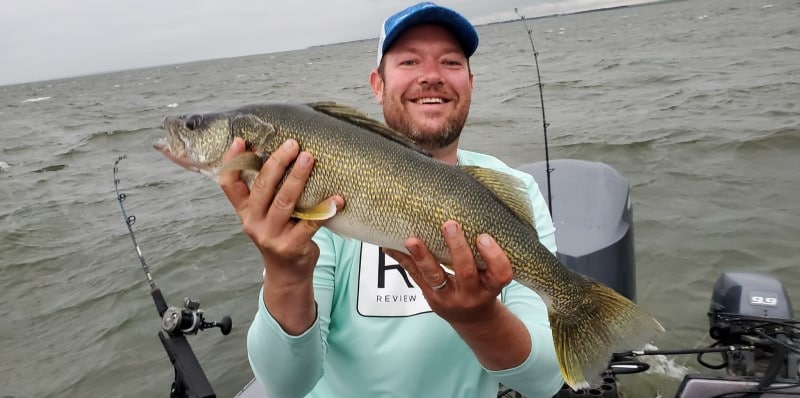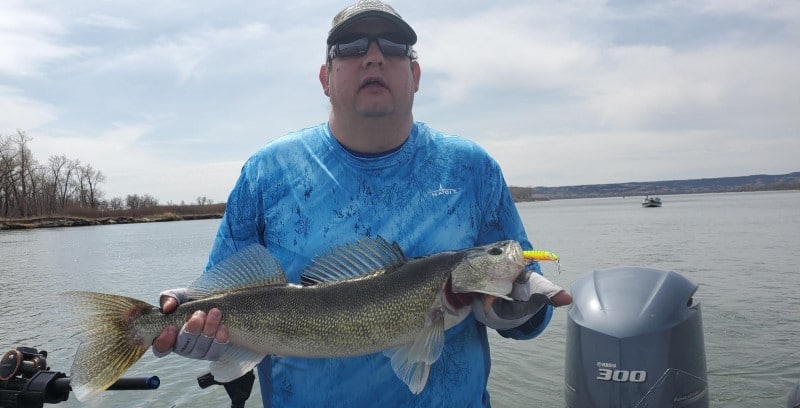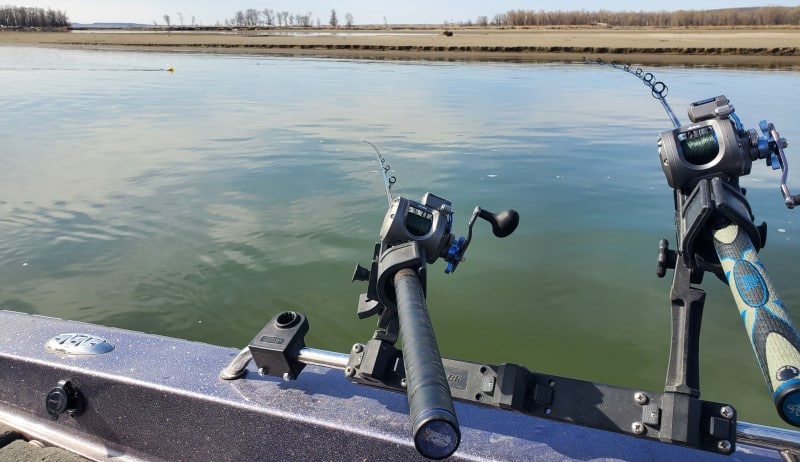Updated on 3/17/21 to reflect new baits…
I love finding efficient ways to catch walleye. And in the springtime, one of the most overlooked techniques in shallow water trolling where the big girls reside.
It’s no surprise that an article such as this comes from me. I’ve been preaching about the effectiveness of walleye trolling for years. It just flat out catches fish, no matter the time of year. But in the spring is when you can use this tactic to really catch the big fish.
For me, I start really trolling as soon as the water temps hit 40 degrees. This year, I was fishing in the middle of ice off on North Dakota’s infamous Lake Sakakawea for a couple of weeks. The water temps were in the upper 30’s and they were so lethargic that cranks just weren’t on my mind. We were pitching jigs as well as fishing vertically, and most bites you didn’t even feel (they just sucked it off the bottom).
When the sun broke out and the air temps reached the 50s through the 70s, the ice went fast and the water temps shot up in a hurry. As stated earlier, when I saw 40 degrees on the graph I knew trolling was now an option.
And this tactic isn’t just for lakes and reservoirs, rivers too. In fact, effective river trolling can bank a lot of walleyes on an average day as well.

Spring Walleye Trolling Tips
Trolling in the spring isn’t a heck of a lot different than the summer or fall. The only real difference is the real estate you’re fishing. Normally in the spring, I rarely fish deeper than 10 feet of water. In fact, in the past couple of weeks, the normal troll depth has been around the 5-7 foot range.
When trolling at this depth, you need to effectively fish them with the right tools and tactics.

Spring Trolling Speeds for Walleye
The key to trolling in the spring is to fish slower than normal. The baits we use are normally better when trolled slower anyways. Walleyes will still react, regardless of the speed, but you’ll put more walleyes in the boat around that 0.8 to 1.3 mph range.
I still like to troll in slight S-curves. This allows the baits to naturally speed up and slow down. Fish are moody this time of year and you need to figure out what they want.
Lures of Choice to Troll in the Spring
The best crankbaits for trolling in the spring can vary depending on the fishery. As they say, start by “matching the hatch” and use baits that mimic the size and shape of the main forage base.
For example, out on Lake Sakakawea and the Missouri River, I have the best luck using long stick baits that mimic smelt. These are longer profile lures that don’t normally dive too deep.

Crankbaits I use most often for shallow water trolling are:
- Rapala Floating Minnows (#7, #9, #11, and #13) – These crankbaits have been around for ages, and they just flat out catch fish. I always use split shots ahead of the crankbait about 1-2 feet. Early in the year, these are killers. I use #13s more than the others, personally, as I like the larger profile.
- Rapala Husky Jerks (Shallow Diving) – When the water starts to warm up and the fish start getting more feisty, I will start moving towards Husky Jerks and away from the Floaters. Rapala Husky Jerks have a wider wobble, creating more strikes. This was our #1 lure of choice this spring.
- Rapala Scatter Raps (Minnow Profiles) – Fellow staff contributor Corey Perman will be pleased to see this one making the list. While I rarely use these normally due to their inconsistencies in reading the rod tip, they flat out caught pigs for us the past few weeks. The “kick” of this crankbait triggers big bites and it shows.
- Berkley Hit Sticks (#11, and #13) – These are new this year (2021), and I will definitely put them to the test. I got a lot of colors and even a few customs for all situations. What’s unique about this lure is its design. Don’t quote me, but I thought I read somewhere that Berkley spent around a decade designing it. It’s hard to beat balsa, but we shall see…
[embedyt] https://www.youtube.com/watch?v=E-bGfIiXWAU[/embedyt]
Other Fishing Equipment Used
Planer Boards

Believe it or not, this is one of the best and most effective times to use planer boards. I like to run a shallow floating minnow behind a planer board up in that 3-foot range when trolling. We catch monster fish using this tactic all spring long.
Planer boards are a great way to target those shallow fish, and at times, the only way to target that shallow range is with a board. Not only do you find big walleyes, but in the spring you’ll find giant pike and other species up shallow too.
The last 2 springs, we’ve even caught salmon doing this as well. Do you think catching salmon is fun??? Try watching a planer board almost fly out of the water…it’s awesome fishing.

I highly recommend Off-Shore Planer Boards for this using tattle flags. If your lure is running too deep, you’ll see it on the flag (flag will start whipping back). This is important to avoid fouling up your most valuable crankbait.
Split Shots
Another tip is to have plenty of Split Shots around for your fishing line. In the spring, it’s not uncommon to see a lot of stuff floating on the surface. When trolling through this, it catches your line and runs down to the lure, fouling it up.
The solution is simple to avoid this, simply run a few small split shots about 2 feet up from your lure. This will catch garbage you don’t want on your lure. Just check it and clean it from time to time, especially when fishing rivers.
Spring is really a simple time for trolling. It’s no secret that the big females are laying up in the shallows, and a slow-running crankbait can be the answer to getting them to snap. No matter how you like to fish, trolling should be one of those options that you should have available if other tactics aren’t working.

Line Counter Reels
This kind of goes almost without saying, but you’ll want to have line counters to fish this way effectively as well as any walleye trolling application. The only way to accurately dial in your bait and know where it’s running is to replicate success. For example, in 6 feet of water, our outside Husky Jerk was 123 feet behind the boat (10.5-foot rod going deep). You simply can’t guess your way through it.

We don’t normally catch huge numbers doing this in the springtime, but the average size of fish is at times, off the charts in comparison to the summer. But when post-spawn sets in, at times you can’t catch fish faster than with a crankbait. Take a little time and give it a run this spring, you may be surprised by the results.
Check out our podcast on trolling as well!
